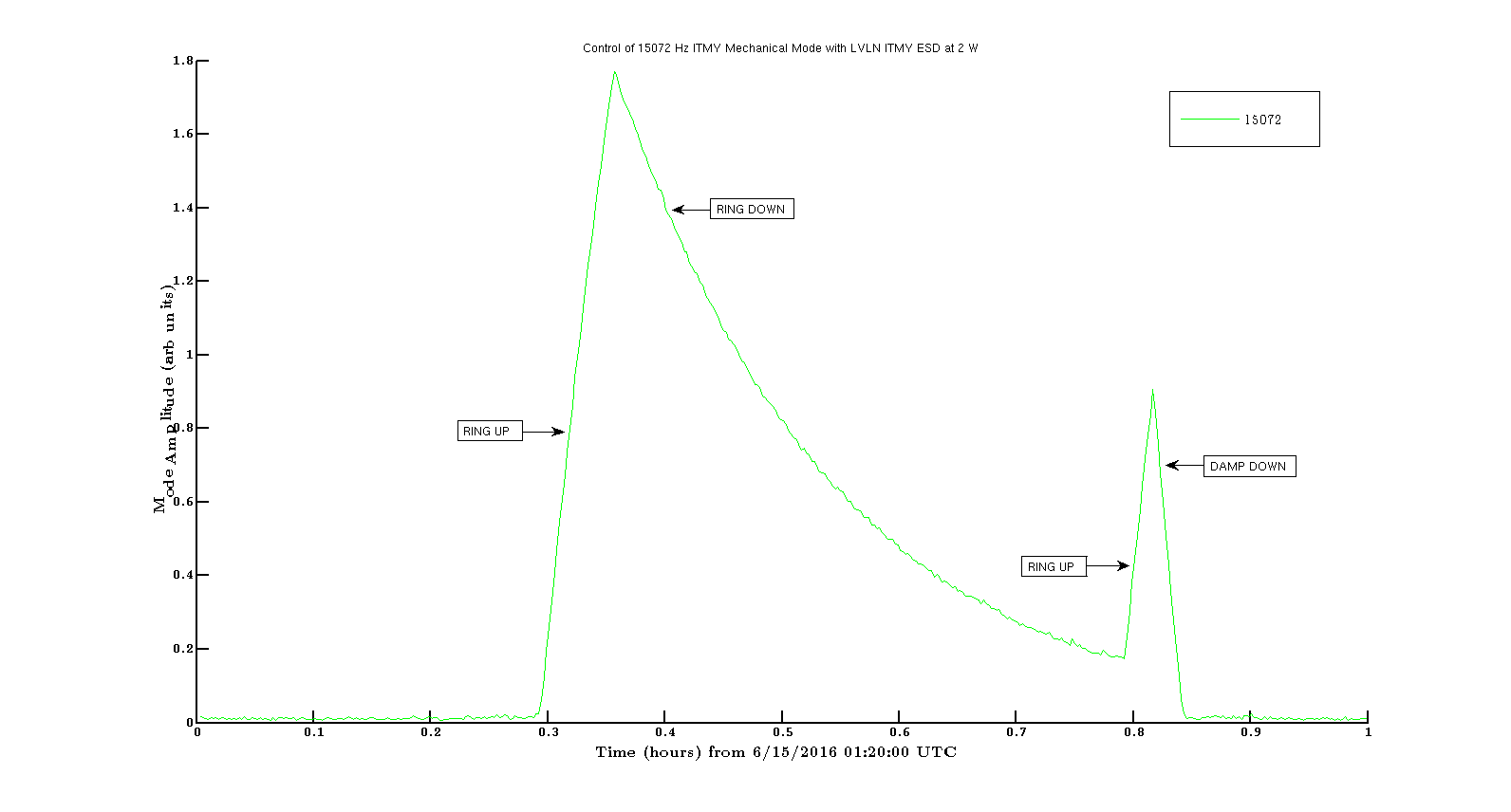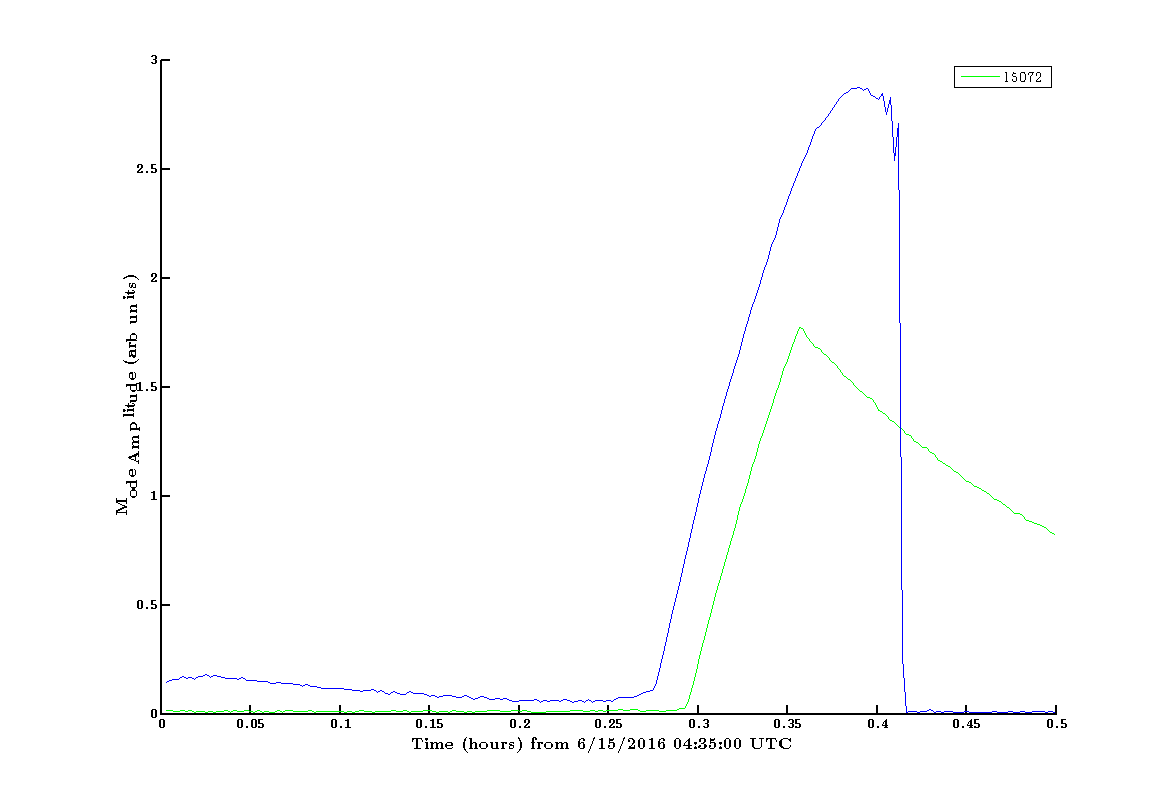Carl, Terra, Rich A.
1. We used the never-before-tested LVLN ITMY ESD driver to ring up and damp two mechanical modes of ITMY, 15072 Hz and 14979 Hz. Below is the amplitude evolution of the 15072 Hz peak as we rang it up, allowed it to ring down naturally, rang it up again, and then damped it down fully with a gain sign flip.

We drove and damped similarly for the 14979 Hz peak. 15072 Hz is the vertical differential drumhead mechanical mode; 14979 Hz is the horizontal version. For both cases, we tightly bandpassed the H1:OMC-PI_DCPD_64KZ_A/B signal, added a +60deg damping filter, and added gain to the damping filter until saturation. Positive gain drove up, negative damped down.
I've fit the natural ring down with f(x) = a * exp(bx), where tau = - (1/b). Then Q = pi * 15072 * tau = 31.5 million.
2. Interestingly, we realized after the above tests that we had not turned the ESD bias on for either ITM. After turning on both to 100K cts (to DC offset), we just had time to ring back up the ITMY 15072 Hz mode before a lockloss. Below is a comparison of the ring ups (note we lost lock and did not damp for the ring down portion below). Green trace is the 15072 Hz ring up without bias, blue trace is with bias (time shifted for ease of comparison).

A slight slope difference is visible but we'll look into this more. Thoughts are that we could use the difference in responses to measure test mass charge coefficients as discussed here and here.
3. We turned ring heaters off and on for future mode-mass identification analysis. For the record (since RH messing with violin modes was a concern tonight):
- 2:36 UTC ETMX RH turned off (ITMX RH was already off)
- 3:00 UTC ETMY RH turned off (ITMY RH was already off)
- 3:32 UTC ITMX RH turned on (0.5 W top and bottom)
- 4:03 UTC ITMY RH turned on (0.5 W top and bottom), ITMX RH turned off
- 4:39 UTC ITMY RH turned off
- 5:56 UTC both ETM RHs turned on (0.5 W top and bottom)
We were also driving the ITMX mode at 15077Hz before and after the bias was turned on. The data is a little more confusing. As the phase was being varied before hand to try find the optimum damping phase. In the plot the amplitude is made to coincide when the damping phase with no bias had the largest response. There was no attempt to optimise the phase in the case where the bias was on other that to try the positive and negative of the previous 'best' phase. Interesting points are:
For the 15077Hz mode the phase that excited the mode was flipped whent he bias was engaged.
The response with the bias engaged is relatively larger when compared to the ITMY 15072Hz mode.
For the 15077Hz mode the amplitude response with bias is about twice the amplitude response without bias.
Mode identification.
In the attached plot the relative change in frequency of the four likely drum head modes around 15200Hz is plotted as a function of time. The ring heaters were adjusted as follows:
ETMX 0.5W per segment to 0W 02:29
ETMY 0.5W per segment to 0W 03:00
ITMX 0W to 0.5W per segment 03:33
ITMX 0.5W per segment to 0W 04:02
ITMY 0W to 0.5W per segment 04:06
ITMY 0.5W per segment to 0W 04:36
The response in frequency shows that the 15218Hz mode is a cooling ETMX, 15219Hz is a cooling ETMY, 15197Hz a heating ITMX and 15192 a heating ITMY mode.
As we were only operating at 2W input the signal to noise ratio of modes is a lot lower and many fewer modes are visible compared to Livingston measurements T1600141.

The following is the list of modes identified.
| Measured Frequencies | Simulated Frequency | ||||||||
| ITMX | ITMY | ETMX | ETMY | ITMX | ITMY | ETMX | ETMY | Shape description | |
| 6044 | 6042 | 6055 | 6054 | 6057 | 6054 | 6053 | 6053 | Butterfly | |
| 8162 | 8160 | 8161 | 8158 | 8194 | 8190 | 8189 | 8188 | Drumhead | |
| 9812 | 9809 | 9829 | 9831 | 9827 | 9827 | 9832 | 9832 | Drumhead | Vertical |
| 9860 | 9863 | 9881 | 9882 | 9879 | 9881 | 9885 | 9885 | Drumhead | Horizontal |
| 10415 | 10437 | 10434 | 10433 | 10432 | 3 point ripple | ||||
| 10423 | 10419 | 10428 | 10426 | 10462 | 10460 | 10463 | 10462 | Drumhead | |
| 12992 | 12988 | 12999 | 13000 | 13022 | 13026 | 13035 | 13036 | Drumhead | Differential |
| 15077 | 15072 | 15093 | 15096 | 15102 | 15103 | Drumhead | Horizontal | ||
| 15197 | 15192 | 15218 | 15219 | 15227 | 15227 | 15232 | 15231 | Drumhead | |
| 15540 | 15545 | 15541 | 15544 | 15544 | Drumhead | Vertical | |||
| 15627 | 15635 | 15632 | 15634 | 15634 | Drumhead | Horizontal | |||
| 19555 | 19553 | 19589 | 19588 | 19595 | 19594 | Drumhead | |||




